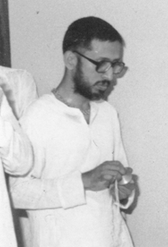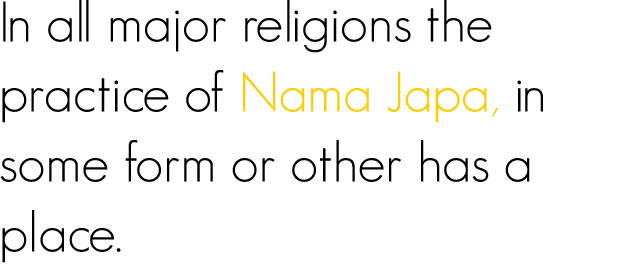

Nama Japa
By Nama Japa we mean not merely the recitation of God’s name, but the contemplation of His qualities and His nature that those words mean. A prayer may not merely be God’s names arranged in a versified form but also includes references to Sri Bhagavan’s heroic exploits on this earth as an Avatara. Often the poet or the seer of the mantra (Mantra Drashta) would add his own prayer for help, either for himself or for humanity. If such a seer was a great bhakta of considerable psychic power, the word of the mantra would be charged with his shakti, which would help the seeker using the mantra created by him, in his progression towards Sri Bhagavan. (see supra chap 4 “Adrishta”) So while the prayer has the shakthi of its creator and that of the seeker reciting it, arising out of the seeker’s sincerity, strength of his abhyasa, love of Guru and God, and mumukshatwa, the power of the mantra increases a million fold when given by a Guru who is anchored in Brahman. Just as when a piece of paper printed with appropriate designs and words become a currency note having a certain value because it is backed by the resources and authority of the central government, so the mantra receives the strength and of the Maha Guru, the Sathguru who authorises its use... Most of the devotees of Shri Sathguru have received from Shri Sathguru some form of upadesha and have felt the flow of Divine Grace. In hard times a source of strength and a refuge, in good times a source of joy and in times of despair, a beacon of hope, the upadesham has always played a major part in the lives of Sri Peetam devotees. How does Shri Sathguru give Upadesham? On the surface it seems very easy. Shri Sathguru tells a particular devotee to recite a particular prayer, go to a certain temple, and fast on a certain day. But in reality Shri Sathguru goes deep into the devotee’s consciousness, finds out the nature of his samskaras and vasanas, his istadevam in his previous birth, progress made then, the nature of his prarabdha karma, his balance of paapa and punya karma and above all his nature and capacity for sadhana and self improvement.
Comparison are odious, especially to one cast in Sathguruvian mould, yet we make the following observations not as a mere comparison but merely to shed light on our Guru that those who follow in those Divine footsteps will understand Who went first, and how easy the path has been made for us to follow. In a book on the Holy Mother, it was pointed out that while the Direct Disciples of her husband, a great saint needed to meditate for 1/2 hour before giving Upadesham in order to know the Purva Janma Samskaras of the aspirant, the holy Mother knew these by meditating for just 10 minutes. We have often seen Shri Sathguru referring to traits and samskaras of persons whom Shri Sathguru has never seen and upadesham has often been given indirectly through sishyas. To illustrate this we give an instance: Once when Shri Sathguru was discussing the freedom movement with some sishyas, one sishya waxed eloquent about a certain freedom fighter who was practically unknown at his time (he died circa 1950). Shri Sathguru said that he must have been an Upasaka of a particular Devata.
“His actions and ideas all show this”. Subsequently the sishya found out that the freedom fighter referred to, had consecrated his whole life to the Devata Shri Sathguru had mentioned in his 16th year and not many persons outside of his immediate family knew of this. Shri Sathguru often says ”from the Sahasranamam one proceeds to the Astotram, from Astotram to the Astakam, from Astakam to the mantra, from Mantra to the Pranava (Om) and from that to total Absorption.” For as Sri Bhagavan says I am easily attainable by that ever steadfast yogi who remembers me daily and constantly to the exclusion of everything else.
